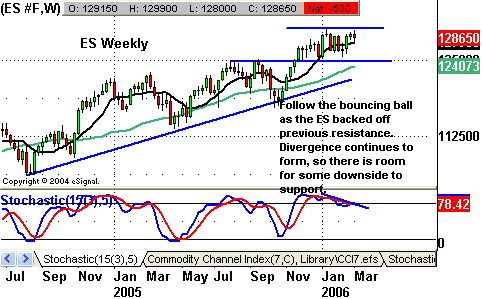Why I think the Fed holds the key for stocks
The major
indexes finished mixed in what was quite a volatile period of trading. With a
shortage of market-moving news, the equities markets struggled to find
direction. The economic data was mixed, as negative housing figures were
coupled with respectable data from the service and manufacturing portions of the
economy. With earnings season over, market players didn’t receive much guidance
from corporate America. However, tech bellwether Intel did issue a pretty
severe warning Friday. Nonetheless, the reaction to the warning was benign, as
it’s been already well known that Intel has fallen behind
(
AMD |
Quote |
Chart |
News |
PowerRating) in microprocessor
innovation. Overall, the indexes just continue to chop in the same range they
have been in for weeks.
While the
key indexes marked time by essentially remaining range-bound for the week, it
was positive to see them hold up so well given the current backdrop. Both short
and long-term interest rates are rising, while housing inventories are rapidly
increasing. The yield curve, which has historically been one of the best gauges
of future economic activity, is inverted across most term structures. Certain
large-cap stocks, which have historically been seen as bellwethers for the U.S.
economy (e.g.
(
GE |
Quote |
Chart |
News |
PowerRating),
(
INTC |
Quote |
Chart |
News |
PowerRating) and
(
JNJ |
Quote |
Chart |
News |
PowerRating)) are trading near their 52-week lows. Normally,
these factors would be very bearish. But, in spite of all of this, the equities
markets have remained relatively steady.
Much of the
reason for this resilient behavior continues to be based on the expectation that
the Fed will stop raising interest rates. Secondly, when compared to the last
10 years, the P/E ratio on the S&P 500 is still reasonable, meaning there isn’t
much overvaluation. Thanks to record profit margins, companies have been able
to enhance their bottom lines and post decent growth rates. An argument can be
made that these record profit margins are temporary, which would likely mean
that current earnings are near a peak for the cycle.
The key in
answering this question of whether or not earnings have peaked again falls back
to the Fed and whether or not it will stop raising rates before it causes a hard
landing for the economy. While it’s true that lower oil prices would also be a
positive, the equities markets pretty much have ignored oil and have moved a
long way under the cloud of higher prices. I continue to believe that interest
rates are the most critical component for the highest-leveraged economy in U.S.
history. With the next FOMC meeting more than 3 weeks away, I can’t see the
equities markets acting any differently that we’ve seen over the past
month. This would mean further range-bound action, as market players wait for
further guidance from the Fed on monetary policy. Because of this, it remains
important to not be flat-footed and to book smaller profits much more readily.
Just a
reminder that we roll over to June as the active futures contract month at the
open on Thursday. The symbol for the June contracts is (M).

Daily Pivots for 3-6-06
| Symbol | Pivot | R1 | R2 | R3 | S1 | S2 | S3 |
| INDU | 11037.63 | 11090.64 | 11159.70 | 11212.71 | 10968.57 | 10915.56 | 10846.50 |
| SPX | 1289.59 | 1294.97 | 1302.72 | 1308.10 | 1281.84 | 1276.46 | 1268.71 |
| ES H6 | 1288.50 | 1297.00 | 1307.50 | 1316.00 | 1278.00 | 1269.50 | 1259.00 |
| SP H6 | 1289.97 | 1295.43 | 1304.47 | 1309.93 | 1280.93 | 1275.47 | 1266.43 |
| YM H6 | 11028.00 | 11095.00 | 11179.00 | 11246.00 | 10944.00 | 10877.00 | 10793.00 |
| BKX | 105.80 | 106.19 | 106.73 | 107.12 | 105.26 | 104.87 | 104.33 |
| SOX | 541.12 | 544.59 | 551.41 | 554.88 | 534.30 | 530.83 | 524.01 |
Please feel free to email me with any questions
you might have, and have a great trading week!
Chris Curran
Chris Curran started his trading career at the
age of 22 with a national brokerage firm. He combines fundamentals and
technicals to get the big picture on the market. Chris has been trading for 15
years, starting full time in 1997, and has never had a losing year as a
full-time trader.
